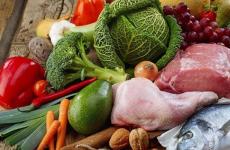How biology is assessed
Federal Service for Supervision in Education and Science
(Rosobrnadzor)
02/27/2019 No. 10-151
Federal Service for Supervision in Education and Science in accordance with clause 21 of the Procedure for conducting state final certification for educational programs of basic general education, approved by order of the Ministry of Education of Russia and Rosobrnadzor dated 07.11.2018 No. 189/1513 (registered by the Ministry of Justice of Russia on 10.12.2018, registration No. 52953) (hereinafter referred to as the Procedure), sends recommendations for use in work on determining the minimum number of primary points confirming the development of educational programs of basic general education by students in accordance with the requirements of the federal state educational standard of basic general education (hereinafter referred to as the minimum number of primary points), recommendations on the transfer of the amount of primary points for examination papers of the main state exam (hereinafter - OGE) and the state final exam (hereinafter - GVE) in a five-point assessment system in 2019.
In accordance with clause 22 of the Procedure, the executive authorities of the constituent entities of the Russian Federation, exercising state administration in the field of education, ensure the conduct of state final certification for educational programs of basic general education, including determining the minimum number of primary points, and also ensure the transfer of the amount of primary points for examination work of the OGE and GVE in a five-point assessment system. Application: 14 liters.
Deputy Head: A.A. Muzaev
A scale for recalculating the primary score for the examination work into a mark on a five-point scale.
Biology.
2019 year.
0-12 points - mark "2"
13-25 points - mark "3"
26-36 points - mark "4"
37-46 points - mark "5"
2018 year.
The maximum number of points that an examinee can receive for completing the entire examination work is 46.
0-12 points - mark "2"
13-25 points - mark "3"
26-36 points - mark "4"
37-46 points - mark "5"
The exam results can be used when admitting students to specialized secondary school classes. A guideline for selection to specialized classes can be an indicator, the lower limit of which corresponds to 33 points.
2017 year.
The maximum number of points that an examinee can receive for completing the entire examination work is 46.
0-12 points - mark "2"
13-25 points - mark "3"
26-36 points - mark "4"
37-46 points - mark "5"
The exam results can be used when admitting students to specialized secondary school classes. A guideline for selection to specialized classes can be an indicator, the lower limit of which corresponds to 33 points.
2016 year.
The maximum number of points that an examinee can receive for completing the entire examination work is 46.
0-12 points - mark "2"
13-25 points - mark "3"
26-36 points - mark "4"
37-46 points - mark "5"
The exam results can be used when admitting students to specialized secondary school classes. A guideline for selection to specialized classes can be an indicator, the lower limit of which corresponds to 33 points.
2015 year.
The maximum number of points that an examinee can receive for completing the entire examination work is 46.
0-12 points - mark "2"
13-25 points - mark "3"
26-36 points - mark "4"
37-46 points - mark "5"
The exam results can be used when admitting students to specialized secondary school classes. A guideline for selection to specialized classes can be an indicator, the lower limit of which corresponds to 33 points.
year 2014.
The maximum number of points that an examinee can receive for completing the entire examination work is 46.
0-12 points - mark "2"
13-25 points - mark "3"
26-37 points - mark "4"
38-46 points - mark "5"
The exam results can be used when admitting students to specialized secondary school classes. A guideline for selection to specialized classes can be an indicator, the lower limit of which corresponds to 33 points.
year 2013.
The maximum number of points that an examinee can receive for completing the entire examination work is 43.
0-12 points - mark "2"
13-24 points - mark "3"
25-35 points - mark "4"
36-43 points - mark "5"
year 2012.
The maximum number of points that an examinee can receive for completing the entire examination work is 40 points.
0-12 points - mark "2"
13-24 points - mark "3"
25-33 points - mark "4"
34-40 points - mark "5"
The exam results can be used when admitting students to specialized secondary school classes. A guideline for selection to specialized classes can be an indicator, the lower limit of which corresponds to 31 points.
2011.
0-11 points - mark "2"
12-21 points - mark "3"
22-32 points - mark "4"
33-43 points - mark "5"
The proposed lower limit of points for marking "3" is a guideline for territorial subject commissions and can be reduced, but not lower than 11 points.
The exam results can be used when admitting students to specialized secondary school classes. A guideline for selection to specialized classes can be an indicator, the lower limit of which corresponds to 32 points.
2010 year.
0-11 points - mark "2"
12-21 points - mark "3"
22-31 points - mark "4"
32-41 points - mark "5"
year 2009.
0-11 points - mark "2"
12-21 points - mark "3"
22-31 points - mark "4"
32-41 points - mark "5"
The exam in biology 2018 is an optional exam, it is completely optional. At the same time, this subject takes 5th place after the obligatory Russian language and mathematics, then social studies and physics. 5th place - for biology (it is chosen by about 18% of graduates).
Where does biology come in handy?
Biology is passed in many universities:
- medical;
- biological universities;
- in the pedagogical department for the specialty "Teacher of Biology";
- in agricultural;
- veterinary;
- at the Faculty of Physical Education;
- psychological;
- ecological;
- at the Faculty of Garden Design;
- at the Faculty of Biology in technical universities, where biology is studied at the interface with physics.
There are a lot of professions related to biology:
- an engineer who simulates problems associated with human life;
- a doctor who will deal with the treatment of diseases that are possible in the future;
- an ecologist who cares about the health of the whole country. The task of the ecologist is to create conditions in which mankind will drink clean water, breathe clean air;
- psychologist;
- athlete.
These are the people who make a person's life more fulfilling and meaningful and, moreover, prolong this life.
Required documents
The FIPI website contains the following documents required to prepare for the exam in history:
- Specification (a description of the work, the necessary documents are listed, the structure of the exam in biology is reflected, a plan of the KIM version is given).
- Codifier (a list of skills and topics that are tested on the exam in biology).
- Demo version of the USE in biology (one version of the USE in biology), with which you need to start preparing for the state exam in history.
Features of the structure of the exam in biology
Total 28 tasks
Part 1 Part 2
21 tasks with a short answer 7 tasks with a detailed answer
The time to complete all the work is 3 hours 30 minutes (210 minutes).
The maximum primary score is 59.
The established minimum test score for the exam in biology is 36 points.
How are the key tasks of part 1 of the work arranged?
Task # 1 first appeared in 2017. Each student, preparing for the exam, reads the text, underlines the keywords, then finds the keywords and connections between them. These connections make it possible to build dependency. Thus, the text is structured, it contains connections between concepts. In this task, a certain fragment from biology is presented, where it is required to show these connections.
Task number 3 is interesting in that ordinary simple tasks have been introduced, where it is required to complete a solution, knowing biology:
- count the number of chromosomes,
- indicate the number of cells that are formed during various processes, etc.
Task number 4 requires you to choose two statements that correspond to the description of the object that is presented.
Task number 6 on genetics. These are problems for monohybrid crossing, where it is required to write a specific number, the ratio of numbers.
Task number 8 on the ratio of examples and phenomena. This is the first example of an assignment. An alternative example of this task is also offered, where a blind drawing (without signatures) is given, and you need to find positions where there are numbers 1 and 2. And only after that, having decided on the position, select the correct answers.
In task number 9, you should find examples from the proposed text that correspond to the concept of "resistance", "microscopicity" and "pathogenicity".
Task number 15 on the knowledge of species properties. In biology, the concept of "species" is the key concept around which all biology is built. Given text. It is necessary to select only those criteria that correspond to the task set in the text.

Task number 20. A new (since 2017), original task, which makes it possible to check several very important, key concepts in biology using one example.
- Example 1 tests the understanding of speciation.
Example 2 involves filling in free columns in the table and finding some relationships between the structure, object and function.
Task number 21.
- Example 1. Formation of natural science literacy and research skills is possible only when a person is able to work with information presented in various forms. In biology, for example, such information is a table where a scientist, observing, fixes data, writes them down, making a certain calculation. The applicant needs to read what is noted here, as a biologist reads it, who chooses key figures from a stockade of numbers and builds conclusions on this basis. You only need to select 2 statements that strictly correspond to the given conditions.
- Example 2 requires the selection of statements that can be formulated based on the analysis of the histogram. For example, you need to find species, see what they eat, encrypt this species (how to depersonalize) and propose the ratio of food addictions of this species. And then it is necessary to evaluate this species, based on its eating habits or some other qualities.
- Example 3 is a graphical representation. It tests the ability to read the graph and understand the reasons for the movement of the curve up or down.
A few words about part 2
These are tasks in an open form, where the graduate will have to answer a question and demonstrate in-depth knowledge of the subject. Particular attention should be paid to the language of the answer. A 11th grade student must own a certain conceptual apparatus, biological terms used in answers to tasks.
What will help to effectively help pass the exam in biology?
Of course, the textbooks used in schools. These can be textbooks by different authors that can be combined.
Clear planning of your activities in preparation for the exam in biology 2018.
Deep interest of the student in the study and delivery of the subject for a high score.
You need to be motivated, you need to want to study the subject of biology, and then the result will not be long in coming.
The date of the exam in biology will be known in January 2018.
You can find out about the results of the USE in biology in 2018 in your educational organization or on the official website of the USE.
If the Ministry of Education decides to make any changes to the CMMs of the Unified State Exam in Biology, then you need to be ready for everything, not waste time and start preparing now!
The 2018-2019 academic year will be the graduation year for many Russian schoolchildren, who are already concerned about the successful completion of the Unified State Exam and successful admission to a good university.
We will tell you how the examination papers are checked in different subjects, how the scale for converting USE scores into grades works, and what innovations can be expected in 2019.
Principles for evaluating the work of the Unified State Examination in 2019
Over the past few years, the USE system in a number of subjects has undergone significant changes and has been brought to the optimal (according to the organizers) format, which makes it possible to fully assess the amount of knowledge of a graduate in a particular subject.
In 2018-2019, no cardinal changes are expected, and it is safe to say that the same principles will be applied to assessing the work of graduates as in 2017-2018:
- automated check of forms;
- involvement of experts in checking tasks with detailed answers.
How does a computer evaluate?
The first part of the examination work involves a short answer to the questions posed, which the USE participant must enter in a special answer form.
Important! Before starting the work, be sure to read the rules for filling out the form, since an incorrectly executed work will not pass an automated check.
It is quite difficult to dispute the result of a computer check. If the work was not counted due to the fault of the participant who incorrectly filled out the form, the result is considered unsatisfactory.
How do the experts assess?
In many subjects, in addition to the test part, there are tasks for which it is necessary to give a full detailed answer. Since it is impossible to automate the process of checking such answers, experts are involved in checking - experienced teachers with extensive work experience.

When checking the exam, the teacher does not know (and even with a great desire cannot find out) whose work lies before him and in which city (region) it was written. The check is carried out on the basis of uniform assessment criteria developed specifically for each subject. Each work is checked by two experts. If the opinion of the experts coincides, the assessment is put on the form, but if the independent appraisers disagree, then a third expert is involved in the verification, whose opinion will be decisive.
That is why it is important to write legibly and accurately so that there is no ambiguous interpretation of words and phrases.
Primary and test scores
Based on the results of the test, the USE participant is awarded a certain number of primary points, which are then converted into text (points for the entire test). Different subjects provide for different maximum primary points, depending on the number of tasks. But after bringing the result according to the corresponding table, the USE participant receives a final test score, which is the official result of his final tests (maximum 100 points).
So, in order to pass the exam, it is enough to collect the established minimum threshold for the primary score:
Minimum points |
||
primary | test |
|
Russian language | ||
Mathematics (profile) | ||
Informatics | ||
Social science | ||
Foreign languages | ||
Biology | ||
Geography | ||
Literature | ||
Based on these numbers, you can understand for sure that the exam has been passed. But what is the grade? The online scale of 2018 will help you with this, designed specifically for transferring primary USE scores into test ones, which will also be relevant for the results of 2019. A handy calculator can be found at 4ege.ru.
Announcement of official results
Graduates are always worried about the question - how quickly can you find out what result was obtained upon passing and what the scale will be in 2019 for translating the points scored on the exam into traditional grades.
Teachers often undertake to reassure the students, working out the tasks of the USE tickets immediately after the exam and assessing the quality of the work done by the students and the amount of primary points scored. The official results must be waited for 8-14 days, in accordance with the established regulations for the USE-2019. On average, the organizers approve the following inspection schedules:
- 3 days to check the work;
- 5-6 days to process information at the federal level;
- 1 working day for the approval of the results of the GEC;
- 3 days for posting results on the network and transferring data to educational institutions.

In the event of unforeseen situations and technical problems, these terms may be revised.
You can find out the owl score:
- directly at your school;
- on the check.ege.edu.ru portal;
- on the website gosuslugi.ru.
Converting scores to grades
Since 2009, the results of the USE are not included in the graduate certificate. Therefore, today there is no official state system for translating the USE result into an assessment on a school 5-point scale. Within the framework of the introductory campaign, it is the test score gained on the exam that is always summed up and taken into account. But, many students are still interested to know how they passed the exam - for 3 or 4, 4 or 5. For this, there is a special table in which the correspondences for each of the 100 points in each of the subjects are detailed.
Russian language | ||||
Mathematics | ||||
Informatics | ||||
Social science | ||||
Foreign languages | ||||
Biology | ||||
Geography | ||||
Literature | ||||
Using such a table is rather inconvenient. It is much easier to find out how you passed the Russian language, mathematics or history using the online calculator 4ege.ru, which also contains a scale for translating USE points, which is relevant for graduates of 2019.

Having received the result of the exam, it is worth deciding on the university as soon as possible, comparing its capabilities with a real competition for specialties of interest. So, the practice of past years shows that in a number of cases it is difficult to get into the most popular areas in the capital's universities even with high scores, because not only the holders of 100-point USE results will compete for places, but also the winners of the largest Olympiads of the 2018-2019 academic year.

There are a lot of professions related to biology. And if a graduate decided to devote his further life to medicine, psychology, pedagogy, food technology, pharmacology or agriculture, then an exam in biology at the end of a secondary school is mandatory for him. What will it be USE in biology 2017?
The state exam in biology in 2017 will be different from the exams of previous years. Not many changes have been made, but they are significant.
A new, more optimized structure of the examination work is proposed. Reduced the number of tasks to 28, compared to 40 in 2016. The maximum number of primary points for all work has been reduced, now it is 59 points, instead of 60 last year. But the amount of time to complete the examination work has been increased to 210 minutes, instead of 180.
The exam will no longer have single-correct-answer questions. In this regard, the probability of guessing is minimized. After all, before it was possible to connect intuition, pass the threshold and score the minimum allowable number of points. Now intuition is not our helper, we need knowledge. You will have to prepare carefully and start as early as possible. But there is good news as well. The difficulty of the tasks has not changed, and the time to complete them has increased by 30 minutes.
The exam paper of the USE in biology 2017 contains 28 tasks, consists of two parts, each of which has its own level of complexity and format.
First part of the exam
The first part consists of 21 tasks with a short answer. Moreover, the answers will need to be written in the form of words or phrases, numbers or a sequence of numbers, without spaces and separators.
The first part includes tasks of two levels of difficulty: 10 - basic level and 11 - advanced.
This format is the first innovation and a good reason for passing the demo version of the exam in biology 2017.
The second innovation in the content of the tasks. The graduate will need:
- analyze information in graphical or tabular form (1 task)
- supplement the missing information in the diagram and table (2 tasks)
- establish the sequence of systematic taxa, biological objects, phenomena, processes (3 tasks)
- solve biological problems in cytology and genetics (2 problems)
- perform tasks with multiple choice (7 tasks) and establish correspondences (6 tasks) with or without a picture
So, 21 tasks of a new type have significant differences and allow you to more accurately assess the knowledge of the material covered, and also require serious preparation.
Second part of the exam (increased difficulty)

The second part of the USE in biology 2017 is aimed at graduates with a high level of knowledge in the subject, or rather, at identifying them. There won't be any changes here. As in 2016, there will be 7 tasks, formed by types of educational activities and in accordance with the topics of the subject. Graduates write the answers to them independently in expanded form. There are also no changes in terms of difficulty: 1 task of the advanced level and 6 of the higher level.
In the second part, the graduate must independently explain and substantiate biological phenomena and processes, be able to analyze, systematize and integrate knowledge, and confirm the theory with practice. And all this should be correctly formulated in a detailed answer.
How is it assessed
The primary maximum number of points for the state exam in 2017 changed, but not significantly.
For completing 10 tasks of the basic level of difficulty, 17 points are given, for 12 tasks of an advanced level - 24 points, for 6 tasks of a high level - 18. In total - 59 points. for passing the exam in biology will be 36 points.
What you need to know

The exam involves testing the knowledge of the subject in full. And if something is missed, even for a good reason, this fact is not taken into account on the exam. Therefore, it is advisable for a future graduate to start preparing for already in September in order to have time to fill in all the gaps.
Biology knowledge testing will be carried out in the following sections:
- Biology as a Science. Methods of scientific knowledge
- Cell as a biological system
- The organism as a biological system
- System and diversity of the biological world
- The human body and its health
- The evolution of living nature
- Ecosystems and their inherent patterns
Use this list to test yourself and pull up overlooked topics.
What you need to be able to

At the exam in biology, it is also important to show your skills and abilities to use the knowledge gained. A graduate must correctly apply terminology, identify biological objects not only by description, but also by drawing. When explaining biological processes, a significant advantage will have those who use not only the word, but also tables, graphs, diagrams. Solve problems, draw conclusions and apply theoretical knowledge in practice, in everyday life.
Every year FIPI publishes an updated demo version of the Unified State Exam in Biology. A graduate has the opportunity to calmly deal with instructions, assignments, rules of conduct, assessment criteria, practically pass all stages of the exam. Of course, the demo version is not an exact copy of the USE, but, nevertheless, it allows the student to feel calmer and more confident when everything is going on for real.
In preparation for the exam in biology, each graduate must take into account his personal, individual characteristics. Everyone knows their strengths and weaknesses, memory capabilities, performance. Those who have not yet figured out this can turn to their parents and teachers for help. It is worth talking to those who have already taken the exam and get additional information first-hand. In a word, all the methods are good for preparation, the main thing is not to leave everything for May, not to hope for "maybe it will carry over", but to start systematically practicing right now.
Biology is one of the subjects that the graduate chooses on the exam himself. And if he makes a choice in favor of biology, then this science is to his liking. Therefore, all worries and worries must be left outside the door so as not to interfere. And take with you composure, confidence, remember everything and get the highest score.
Video news, demos
| date | Unified State Exam |
|---|---|
| Early period | |
| March 20 (Fri) | geography, literature |
| March 23 (Mon) | Russian language |
| March 27 (Fri) | mathematics B, P |
| March 30 (Wed) | foreign languages (except for the section "Speaking"), biology, physics |
| April 1 (Wed) | |
| April 3 (Fri) | social studies, informatics and ICT |
| April 6 (Mon) | history, chemistry |
| April 8 (Wed) | reserve: geography, chemistry, computer science and ICT, foreign languages (section "Speaking"), history |
| April 10 (Fri) | reserve: foreign languages (except for the section "Speaking"), literature, physics, social studies, biology |
| April 13 (Mon) | reserve: Russian language, mathematics B, P |
| The main stage | |
| May 25 (Mon) | geography, literature, informatics and ICT |
| May 28 (Thu) | Russian language |
| June 1 (Mon) | mathematics B, P |
| June 4 (Thu) | history, physics |
| June 8 (Mon) | social science, chemistry |
| June 11 (Thu) | foreign languages (except for the section "Speaking"), biology |
| June 15 (Mon) | foreign languages (section "Speaking") |
| June 16 (Tue) | foreign languages (section "Speaking") |
| June 18 (Tue) | reserve: history, physics |
| June 19 (Fri) | reserve: geography, literature, informatics and ICT, foreign languages (section "Speaking") |
| June 20 (Sat) | reserve: foreign language (except for the section "Speaking"), biology |
| June 22 (Mon) | reserve: Russian |
| June 23 (Tue) | reserve: social science, chemistry |
| June 24 (Wed) | reserve: history, physics |
| June 25 (Thu) | reserve: mathematics B, P |
| June 29 (Mon) | reserve: in all academic subjects |
In 2018, more than 133 thousand people took part in the USE in biology, which is slightly more than the number of exam participants in 2017 (111 748) people, 2016 (126 006) and 2015 (122 936). The biology exam is traditionally in demand and is one of the five most popular elective final exams. It is chosen by graduates motivated by biology who enter medical, veterinary, agricultural universities, psychological and biological faculties of universities, academies and institutes of physical culture and sports, and a number of other universities.
In 2018, the average test score was 51.4. Its slight decrease compared to last year is primarily due to a decrease in the proportion of participants in the range of test scores 61–80 (by 2.26%) and an increase in the proportion of participants in the range of 41–60 (by 3.26%). At the same time, there is a persistent downward trend in the number of participants with results in the range of 81-100. The decrease in the share of high-scorers can be explained by a set of measures to improve the quality of verification of detailed answers by experts of the subject commissions of the regions, as well as by the inclusion in part 2 of KIM of new plots of a specific, contextual, practice-oriented nature that required clear argumentation, and not reproduction of general or particular knowledge on the subject. This allowed for a better differentiation of the participants with high test scores.
The minimum test score in 2018, as in previous years, was 36 points, and the primary - 16 points. The share of USE participants in biology who did not score the minimum number of points in 2018 was 17.4%. Compared to 2017, the share of participants who scored test scores in the 41-60 range was 40.6% (in 2017 - 37.3%), and in the 61-80 range it was 25.6% (in 2017 - 27.9%).
In 2018, 48 graduates completed all the tasks of the examination and scored 100 points, which amounted to 0.04% of the total number of USE participants. The data obtained testifies, on the one hand, to a fairly high level of complexity of the KIM USE 2018 model and, on the other hand, to the availability of tasks, which is confirmed by the distribution of the participants' primary and test scores.
More detailed analytical and methodological materials of the USE 2018 are available here.
Our website contains about 5500 tasks to prepare for the Unified State Exam in Biology in 2018. The general outline of the examination work is presented below.
THE EXAMINATION PLAN OF THE USE IN BIOLOGY 2019
Designation of the level of difficulty of the task: B - basic, P - increased, C - high.
Verifiable content items and activities |
Difficulty level of the task |
Maximum score for completing the task |
| Exercise 1. Biological terms and concepts. Schema completion | ||
| Task 2. Biology as a Science. Methods of scientific knowledge. Levels of organization of the living. Working with a table | ||
| Task 3. Genetic information in the cell. Chromosome set, somatic and germ cells. Solution of a biological problem | ||
| Task 4. The cell as a biological system. Cell life cycle. Multiple choice (with and without fig.) | ||
| Task 5. The cell as a biological system. Cell structure, metabolism. Cell life cycle. Establishing compliance (with fig. And without fig.) | ||
| Task 6. Mono- and dihybrid, analyzing crosses. Solution of a biological problem | ||
| Task 7. The organism as a biological system. Selection. Biotechnology. Multiple Choice (no fig. And with fig.) | ||
| Task 8. The organism as a biological system. Selection. Biotechnology. Establishing compliance (with fig. And without fig.) | ||
| Task 9. Variety of organisms. Bacteria, Fungi, Plants, Animals, Viruses. Multiple choice (with and without fig.) | ||
| Task 10. Variety of organisms. Bacteria, Fungi, Plants, Animals, Viruses. Establishing compliance (with fig. And without fig.) | ||
| Task 11. Variety of organisms. The main systematic categories, their subordination. Sequencing | ||
| Task 12. Human organism. Human hygiene. Multiple choice (with and without fig.) | ||
| Task 13. Human organism. Establishing compliance (with fig. And without fig.) | ||
| Task 14. Human organism. Sequencing | ||
| Task 15. The evolution of living nature. Multiple choice (working with text) | ||
| Task 16. The evolution of living nature. Human Origins. Establishing compliance (not shown) | ||
| Task 17. Ecosystems and their inherent patterns. Biosphere. Multiple Choice (not shown) | ||
| Task 18. Ecosystems and their inherent patterns. Biosphere. Establishing compliance (not shown) | ||
| Task 19. General biological laws. Sequencing | ||
| Task 20. General biological laws. Man and his health. Working with the table (with fig. And without fig.) | ||
| Task 21. Biological systems and their patterns. Data analysis, in tabular or graphical form | ||
| Task 22 (C1). Application of biological knowledge in practical situations (practice-oriented task) | ||
| Task 23 (C2). Assignment with the image of a biological object | ||
| Task 24 (C3). Assignment for the analysis of biological information | ||
| Task 25 (C4). Generalization and application of knowledge about man and the diversity of organisms. | ||
| Task 26 (C5). Generalization and application of knowledge in a new situation about the evolution of the organic world and ecological laws in a new situation | ||
| Task 27 (C6). Solution of problems in cytology for the application of knowledge in a new situation. | ||
| Task 28 (C7). Solving problems in genetics for the application of knowledge in a new situation |
Correspondence between the minimum primary scores and the minimum test scores of 2019. Order on amendments to Appendix No. 1 to the order of the Federal Service for Supervision in Education and Science.






